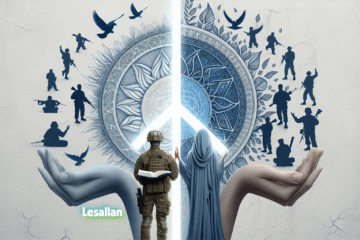Written By Lesallan | Published on February 16, 2025

The Symbolism of Birds in Biblical Verses and Across Cultures
The Bible is a profound book that combines spiritual guidance and literary beauty. It often highlights the wonders of nature to share important messages that connect with our everyday lives. Birds, in particular, hold special meaning throughout the Bible, symbolizing various lessons about life and morality.
In this essay, we will explore the significance of birds in two well-known verses from the King James Bible: Matthew 6:26 and Song of Solomon 2:12. We’ll also look at how different cultures view birds’ symbolism, which helps deepen our understanding of their important meaning.
In Matthew 6:26, Jesus encourages His followers to consider the birds of the air. He notes that these birds do not plant crops, harvest them, or store food in barns. Yet, despite their lack of earthly labor, they are still nourished and cared for by God. This verse serves as a powerful reminder of His loving provision for all of creation. The key message is clear: if God faithfully looks after the birds, then He will certainly care for humans as well, who are even more precious in His eyes. This teaching invites us to place our trust in God’s provision rather than succumbing to anxiety about our needs, fostering a sense of peace and reliance on Him.
In contrast, the Song of Solomon is a poetic and lyrical work that celebrates love, beauty, and the joys of nature, enhancing the reader’s appreciation of birds through its vivid imagery. In Song of Solomon 2:12, we find the verse, “The flowers appear on the earth; the time of the singing of birds comes, and the voice of the turtle is heard in our land” (KJV). This passage immerses us in themes of renewal and rebirth, capturing the essence of spring, when nature awakens from its winter slumber. The singing of birds symbolizes joy, harmony, and the rejuvenation of life, serving as a metaphor for the blossoming of love and romantic relationships. The delightful sounds of birds contribute to the serene and picturesque imagery woven throughout the text, encapsulating the cyclical renewal of life and the beauty that emerges with each new season (King James Bible, 1611).
Beyond their biblical significance, birds hold profound symbolism in various cultures. Many traditions perceive birds as messengers that connect the earthly realm to the divine, embodying spiritual freedom and transcendence. For example, in Native American cultures, birds symbolize community, freedom, and a connection to nature. Similarly, in ancient Egyptian symbolism, birds such as the falcon represent divine authority and are associated with the afterlife. Across diverse cultures, birds encapsulate the duality of existence, symbolizing both freedom and home, and reflecting the journey of the human spirit.
In conclusion, the symbolism of birds in the Bible serves as a profound reminder of nature’s capacity to communicate spiritual truths. From Jesus’s teachings in Matthew regarding divine provision to the poetic imagery of love and renewal in the Song of Solomon, birds enhance our understanding of faith, love, and the cycles of life. Their significance extends beyond biblical texts, resonating within cultural narratives across the globe, thereby deepening our appreciation for these remarkable creatures and the universal messages they embody.
Birds have been celebrated in various cultures for centuries, each species steeped in rich symbolic meanings that reflect the values, beliefs, and spiritual interpretations of the societies that venerate them. For example, in Hinduism, the peacock symbolizes beauty, knowledge, and artistic expression, whereas in Japanese culture, the crane represents longevity and happiness. These diverse interpretations of bird symbolism enhance our understanding of the significant roles that birds play within different cultural narratives.
In Native American cultures, the eagle stands as a significant symbol, representing strength, courage, and spiritual enlightenment. Often regarded as a messenger between the earthly and the divine, the eagle’s majestic flight signifies a connection to higher realms, making it a compelling emblem of vision and freedom. In contrast, the raven carries a dual significance; it is viewed as a transformative figure linked to creation, healing, and at times, trickery. Its dark plumage evokes an air of mystery and intelligence, underscoring its role in various mythologies as a bridge between worlds.
In ancient Egyptian culture, the ibis, associated with the god Thoth, serves as a symbol of knowledge and learning, reflecting its ties to writing and wisdom. The falcon, representing the sky god Horus, embodies divine kingship and protection, illustrating the ruler’s connection to the heavens and their role as guardians of the people.
Chinese culture venerates the phoenix as a potent symbol of rebirth, immortality, and elegance. Its mythological voyage through cycles of death and resurrection resonates profoundly, embodying renewal and the harmonious balance of existence. Similarly, the crane holds significant meaning in Chinese symbolism, representing longevity, peace, and fidelity. It is frequently associated with romantic love and the joys of the life journey.
In Greek and Roman mythology, the owl holds a revered status as sacred to Athena, the goddess of wisdom. It symbolizes knowledge, insight, and foresight. Often depicted alongside Athena, this wise bird embodies the pursuit of understanding and enlightenment. In contrast, the peacock, associated with Hera, represents immortality and beauty, showcasing the splendor and grace of life.
Celtic traditions regard the swan as a powerful symbol of purity and love, intricately linked to ideas of transformation and intuition. The elegant gliding of the swan across tranquil waters evokes a sense of serenity and fosters a deep connection to the self. In contrast, the raven in Celtic lore represents prophecy and protection, often considered a harbinger of change.
In Japan, the crane is a cherished symbol of longevity and happiness, admired for its grace and elegance. It is associated with wishes for good fortune and lasting love. In contrast, the sparrow embodies loyalty, simplicity, and the strength of community, serving as a reminder of the beauty found in shared experiences and the richness of everyday life.
In Hinduism, the peacock holds profound symbolic meaning associated with the goddess Saraswati, embodying beauty, knowledge, and artistic expression. The peacock’s vibrant plumage serves as a reminder of the splendor of enlightenment. In contrast, Garuda, the legendary bird and mount of Lord Vishnu, represents strength, martial prowess, and the protective attributes of the divine. Garuda’s immense power and his role as a guardian elevate him to a revered status among spiritual figures within Hindu belief.
Birds function as persistent symbols within various cultural frameworks, each species representing distinct attributes that illuminate the intricate interplay of human experience, spirituality, and the natural environment. Their roles in mythology and cultural narratives highlight humanity’s enduring relationship with nature, emphasizing the timeless teachings derived from such interactions. Through these representations, birds encapsulate the multifaceted dimensions of human existence and contribute to a broader understanding of ecological and spiritual interconnectedness.
The biblical verses, particularly those found in the Gospel of Matthew and the Song of Solomon, serve to illustrate how birds function as potent symbols that convey significant spiritual meanings. In Matthew 6:26, Jesus offers reassurance to believers regarding God’s steadfast care and providence by employing the imagery of birds in the sky. He emphasizes that God provides for these creatures, which do not engage in sowing or reaping, thereby highlighting that if God attends to the needs of even the smallest of His creations, it stands to reason that He is equally attentive to our needs.
Conversely, Song of Solomon 2:12 utilizes the imagery of birds to celebrate the beauty and renewal inherent in both the natural world and love itself. The blossoming of nature, accompanied by the cooing of doves, symbolizes a period of joy, unity, and the vibrancy of romantic love. This verse encapsulates the essence of spring—a season linked to rebirth and rejuvenation, where love thrives alongside the revival of nature.
Moreover, the symbolic significance of birds extends beyond biblical texts, resonating throughout diverse cultures and traditions. In many societies, birds are perceived as messengers bridging the earthly and the divine, embodying themes of freedom, transcendence, and spiritual awakening. Their ability to soar high in the sky frequently symbolizes hope, strength, and the pursuit of higher aspirations.
In summary, the motifs of birds within these biblical verses underscore not only God’s care and the beauty of love but also resonate with a universal truth shared across cultures worldwide. Birds have long been regarded as significant symbols, embodying essential themes of providence, love, resilience, and renewal. They serve as reminders of the interconnectedness of all living beings and the profound spiritual insights that can be gleaned from observing nature.
References:
King James Bible. (1611). The Holy Bible, King James Version. Retrieved from
https://www.kingjamesbibleonline.org



